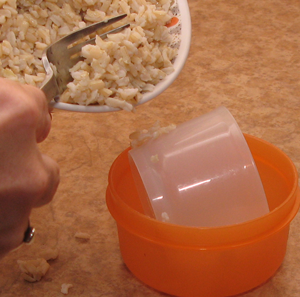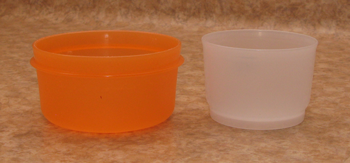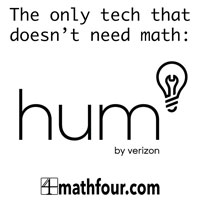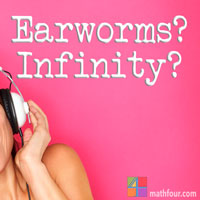Are you teaching sets? Some of the stuff that you talk about in set theory is pretty clear – you have a basket { } and you put stuff in it {♥, ✂, ☎, ✿}. No problem.
But what’s the deal with the basket with no stuff in it?
That’s the empty set. It’s written like Ø or simply as the “basket” like this: { }.
But kids might be tempted to write {Ø} – and then they get it wrong. BUT WHY?
The empty set is an object!
Suppose you have four empty sets. Do you have nothing? Nope – you have four containers. Just check your cabinets – I’m guessing you have a handful of empty sets in there with the Rubbermaid® or Tupperware® logo on them.
And {Ø} is an object inside a set.
Supposed you put one inside the other, like this:

This is the same as {Ø}. Would you be willing to put leftovers inside the bigger one while the smaller one is there? It would be something like this:

Instead, wouldn’t you be more likely to remove one empty set from the other and have just Ø and Ø (no curly brackets) like this:

What do you think? Does this help you understand the empty set? Will it help you teach it?
Related articles
- What’s a Function?
- How to Tell if Your Child Is a Top-Down Learner
- 50 Word Friday – The Math Mini-Saga Series

This post may contain affiliate links. When you use them, you support us so we can continue to provide free content!








I think that the analogy might be misleading, because you can have many empty containers, but there is only one empty set. A set is like a container in some ways; but unlike a container, a set is determined by its elements. Two sets that contain the same elements are identical, but two distinct containers could have the same contents, or no contents.
I do agree that the analogy can be useful, but one should avoid phrases such as “two empty sets” which can cause misconceptions.
Wow, Dave. You’re totally right.
Which makes me really think about the possibility of having different empty sets. Since the empty set is an element of the power set of any set, might the empty set as an element of the power set of integers be technically different than the empty set as an element of the power set of the set of polynomials (for instance)? I guess, no. But something feels like it might be yes.
If we say, “There’s nothing in it,” it might be very different if we know what the possible things are that MIGHT be in it.
Wondering…
Hmm. The axiom of extensionality states that two sets are equal if and only if they have the same elements. This is a standard axiom of set theory, and it implies that the empty set is unique.
But it does seem to me that there are instances where we would want to allow different sets to have the same elements. For example, suppose that a high school has a math club and a chess club. It might happen that the two clubs have the same membership list, but we would still consider the clubs to be different. Maybe there is a non-standard set theory that would model this situation.
Don’t confuse the name of something with the thing itself. Two clubs can have the same set of members, just like you can define sets S=\emptyset and T=\emptyset. Four containers gives you four copies of the empty set, which we lazily call four empty sets. (Except that some students will correctly think that the containers are not empty, and have different sets of air molecules.)